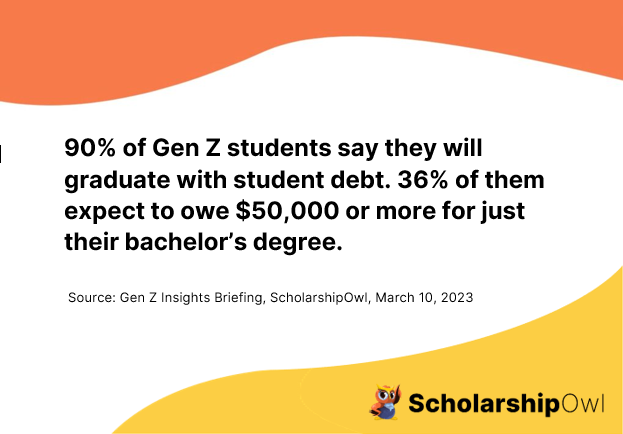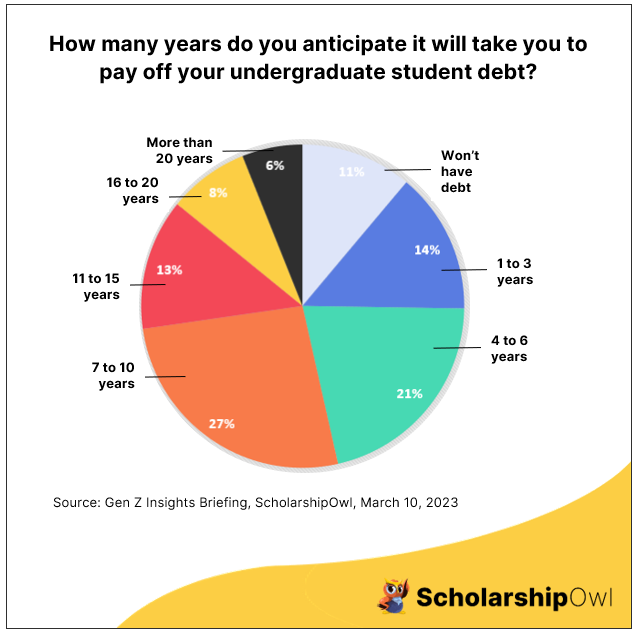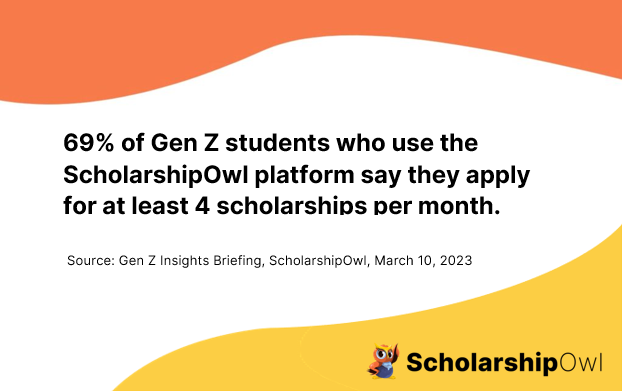To develop a deeper understanding of Gen Z, ScholarshipOwl conducts a survey every month to assess key trends impacting high school and college students.
With Supreme Court decisions looming regarding the Biden Administration’s plans for student debt forgiveness, our February 2023 survey focused on student loan debt expectations as well as a better alternative to loans – applying for scholarships. This research is especially relevant today, given that 30% of undergraduates take on federal student debt, and 13% of students carry student loans from banks or other private sources.
Who participated in the survey?
In February 2023, ScholarshipOwl surveyed over 8,000 high school and college-aged students on the ScholarshipOwl scholarship platform to learn more about the impact of student debt on today’s Gen Z students. A total of 8,155 students responded to the survey. 33% of the respondents were undergraduates, primarily college freshmen; 58% were high school students, with the vast majority high school seniors; 6% identified themselves as graduate students; and 4% identified themselves as adult/non-traditional students.
Survey questions
The first survey question was “Which best describes how much student debt you expect to carry when you graduate with your bachelor’s degree?” Respondents were asked not to include anticipated debt from graduate school.
The fastest path to earning scholarships
Simplify and focus your application process with the one-stop platform for vetted scholarships.
The overwhelming majority (90%) responded that they expect to carry some amount of undergraduate student debt upon graduation, with just 10% indicating they did not expect to graduate with any student debt. The full breakdown:
- 10% do not expect to graduate with undergraduate student debt
- 6% expect to have up to $5000 in undergraduate student debt
- 9% expect to have $5000 – $10,000 in undergraduate student debt
- 13% expect to have $10,000 – $20,000 in undergraduate student debt
- 14% expect to have $10,000 – $20,000 in undergraduate student debt
- 13% expect to have $20,000 – $30,000 in undergraduate student debt
- 11% expect to have $30,000 – $40,000 in undergraduate student debt
- 9% expect to have $40,000 – $50,000 in undergraduate student debt
- 11% expect to have $50,000 – $75,000 in undergraduate student debt
- 9% expect to have $75,000 – $100,000 in undergraduate student debt
- 7% expect to have over $100,000 in undergraduate student debt

As a follow-up question, we asked, “How many years do you anticipate it will take you to pay off your undergraduate student debt?” The majority of respondents (61%) believed that they would be free of their student debt within 10 years. This expectation vastly differs from the stark reality of student debt. A survey of over 60,000 respondents conducted by One Wisconsin Institute indicated that the average student takes over 20 years to pay off their undergraduate student loans.
The full breakdown of our participants’ responses regarding undergraduate student debt:
- 11% do not expect to graduate with student debt.
- 14% expect their student debt to be paid in 1 to 3 years
- 21% expect their student debt to be paid in 4 to 6 years
- 26%expect their student debt to be paid in 7 to 10 years
- 13% expect their student debt to be paid in 11 to 15 years
- 8% expect their student debt to be paid in 16 to 20 years
- 6% expect it will take more than 20 years to pay off their student debt

The final survey question asked was “On average, how many scholarships do you apply for each month?” Here, we have some good news. 69% of respondents indicated that they apply for at least 4 scholarships per month – and of this amount, 22% apply for at least 11 scholarships per month. These results demonstrate that most students who use the ScholarshipOwl platform to apply for scholarships apply for significantly more scholarships year-round as compared to the students and parents surveyed in a 2022 Sallie Mae study. This study found that just 48% of respondents searched for and applied for scholarships throughout the year.

The full breakdown of responses:
- 5% of respondents indicated that, on average, they apply for less than 1 scholarship per month
- 26% apply for 1 to 3 scholarships per month
- 29% apply for 4 to 6 scholarships per month
- 19% apply for 7 to 10 scholarships per month
- 7% apply for 11 to 15 scholarships per month
- 15% apply for more than 15 scholarships per month
To a certain extent, these results aren’t surprising, given that the survey was conducted among students who use the ScholarshipOwl platform to apply for scholarships. As such, this population of Gen Z students do proactively apply for scholarships to reduce their out-of-pocket college cost. What is interesting is that the Sallie Mae study found that 40% of students did not receive any scholarships and/or grants to reduce their cost of college – but 68% of these students didn’t even apply for them.
Clearly, prioritizing applying for scholarships can make a significant impact on a student’s ability to pay for college, which in turn reduces the likelihood of needing to rely on student loans.
Key Takeaways for Gen Z students
The survey results indicate that Gen Z students vastly underestimate how long it will take them to pay-off their undergraduate student debt. Due to this, students are woefully unprepared for the reality of graduating with student debt, and its impacts on their future.
Students who graduate with student debt delay major life milestones. According to a 2022 national survey of over 5,000 adults conducted by CNBC/Momentive, 81% of adults with student loans report such delays, with 33% delaying buying a home, 40% delaying investments, and 38% delaying saving for their retirement. 14% postpone getting married, and 16% postpone having children. Student debt creates other burdens that also weigh heavily on borrowers, with 62% of respondents indicating adverse impacts on their mental health.
Gen Z students need to better understand how student debt can impact their future. Families, educators, and guidance counselors can be part of this solution, by ensuring that students not only are more educated about student loans, but also by helping Gen Z students prioritize applying for scholarships as an alternative to loans.
How can brands help?
While there are many federal and state grants available for low-income students, these programs typically only cover tuition costs. Room and board is often more expensive than tuition at public universities. And middle-income students receive little help from federal and state programs.
Scholarships are an alternative that can support students across the income spectrum, yet there are not nearly enough scholarships available to meet the need.
Brands can be part of the solution by offering scholarship campaigns that support students, while also fulfilling their business and philanthropic goals. Brands can access the ScholarshipOwl for Business platform to streamline the scholarship campaign creation process. Once a scholarship campaign is launched, the scholarship is broadcast out to the millions of students who apply for scholarships on the ScholarshipOwl platform. The campaigns can be promoted via email as well, helping to maximize the number of applicants for each scholarship campaign. Success metrics are readily available via our advanced analytics dashboard, enabling brands to gain insights that can inform future scholarship campaigns.
To find out more about creating and launching a scholarship campaign, visit business.scholarshipowl.com.